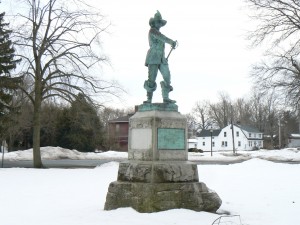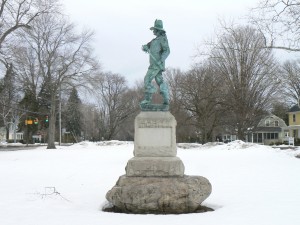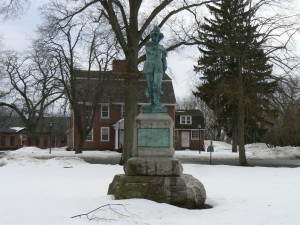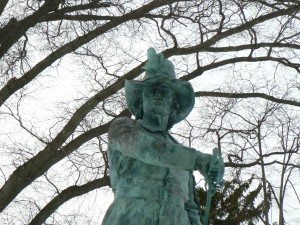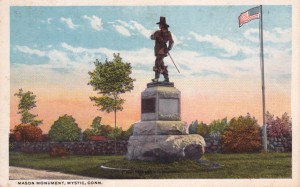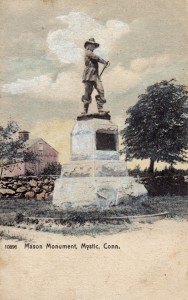UPDATE: Scheduled for removal in July of 2020
An 1889 monument to English settler John Mason illustrates how our attitudes toward historic people and events can change over time.
The monument, which stands today on Windsor’s Palisado Green, depicts Mason, in 17th century clothing, drawing a sword.
A dedication plaque on the west face of the monument’s base reads, “Major John Mason. Born 1600 in England. Immigrated to New England in 1630. A founder of Windsor, Old Saybrook and Norwich. Magistrate and Chief Military Officer of the Connecticut Colony, Deputy Governor and acting Governor. A Patentee of the Colonial Charter. Died 1672 in Norwich. Erected at Mystic in 1889 by the State of Connecticut, this monument was relocated in 1996 to respect a sacred site of the 1637 Pequot War.”
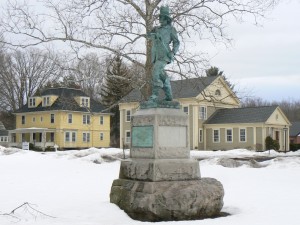 As the plaque indicates, the Mason monument was dedicated in 1889 on Pequot Avenue in the Mystic section of Groton. The monument was built to mark the site of a former Pequot settlement that Mason burned in 1637, and to honor Mason’s contributions to the defeat of the Pequots by English settlers.
As the plaque indicates, the Mason monument was dedicated in 1889 on Pequot Avenue in the Mystic section of Groton. The monument was built to mark the site of a former Pequot settlement that Mason burned in 1637, and to honor Mason’s contributions to the defeat of the Pequots by English settlers.
At the time, the monument bore a dedication reading, “Erected AD 1889 By the State of Connecticut to commemorate the heroic achievement of Major John Mason and his comrades, who near this spot in 1637, overthrew the Pequot Indians, and preserved the settlements from destruction.”
Estimates place the number of Pequots killed by Mason’s forces between 400 and 700. In July of 1637, a small group of Pequot warriors was defeated in Fairfield’s Great Swamp Fight, and fighting between the settlers and the natives came to a close.
 In late 1992, local Pequots (who, thanks to the development of Foxwoods, had considerably more economic and political influence than they had when the monument was dedicated a century earlier) began efforts to have the Mason monument removed from the massacre site, which they considered sacred ground.
In late 1992, local Pequots (who, thanks to the development of Foxwoods, had considerably more economic and political influence than they had when the monument was dedicated a century earlier) began efforts to have the Mason monument removed from the massacre site, which they considered sacred ground.
After debate about the historic context of the monument’s original dedication and today’s differing views about Native Americans, the Mason monument was moved from Mystic to Windsor, and the dedication plaque was changed to reflect Mason’s political contributions to that town, Old Saybrook and Norwich.
The Mason statue was created by sculptor James C.G. Hamilton, whose other works included a Civil War monument in Muskegon, Michigan, and a bronze statue of Cleveland founder Moses Cleaveland.
Tags: Windsor
